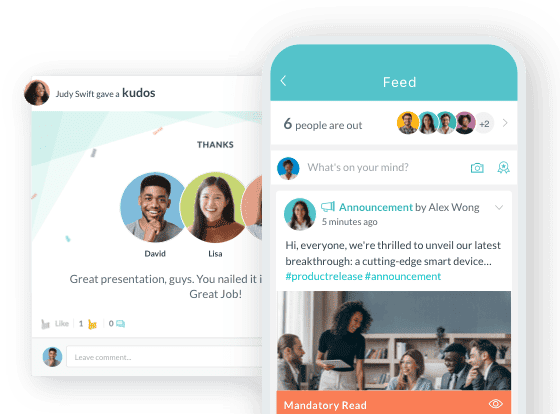What Are the Best Workvivo Alternatives for Employee Experience in 2025?
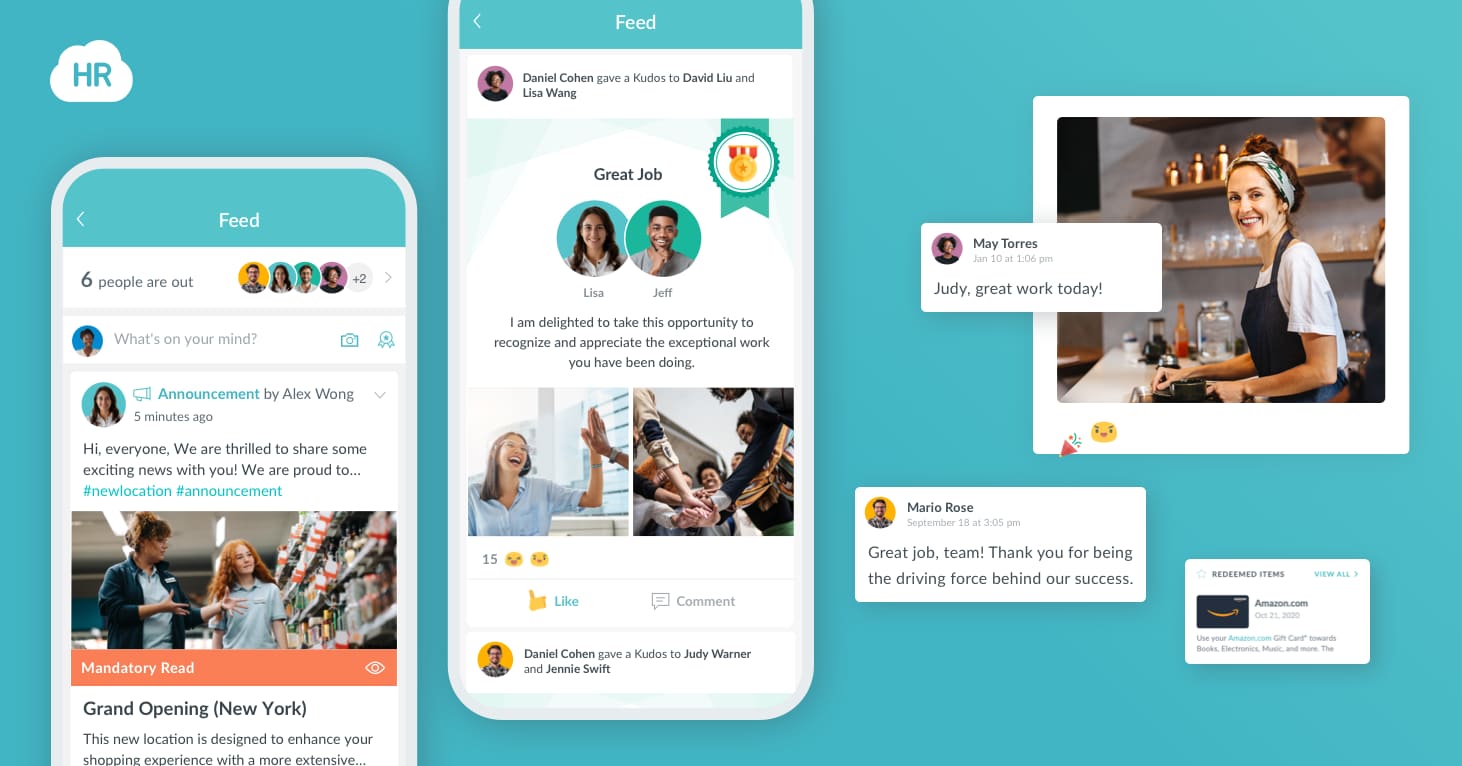
- What Should You Actually Demand from an Employee Experience Platform?
- How Do Workvivo Alternatives Compare on Key Features?
- Which Workvivo Alternatives Have the Most User Complaints?
- What Problems Do All These Alternatives Create?
- How Does HR Cloud Solve These Common Platform Problems?
- Real Scenarios: When HR Cloud Makes More Sense Than Alternatives
- The Questions That Expose Platform Weaknesses During Evaluations
- Pricing Reality: What You'll Actually Pay (And What Vendors Hide)
- How Organizations Actually Measure Success With HR Cloud
- Making Your Final Decision: Why HR Cloud Makes Practical Sense
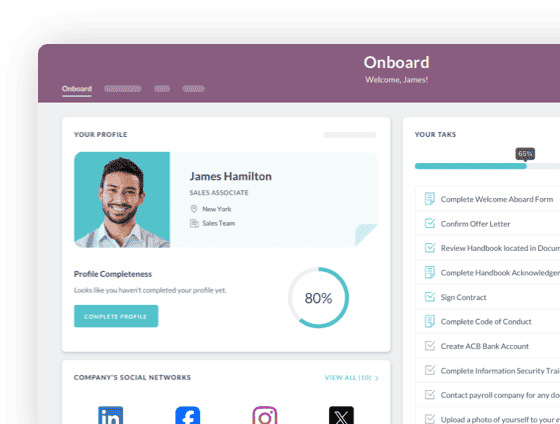
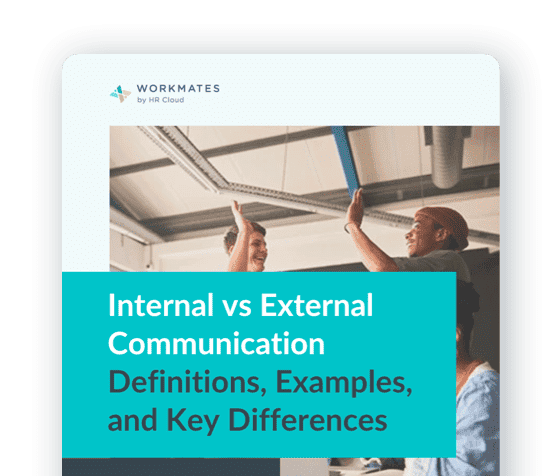
 Cut onboarding time
by 60%—here's the
Ultimate Checklist
that helped do it.
Cut onboarding time
by 60%—here's the
Ultimate Checklist
that helped do it.
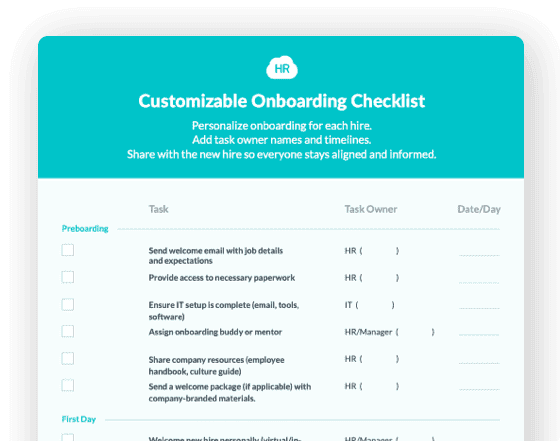
Workvivo delivers solid employee engagement through social feeds and community features, but it falls short where organizations actually need help—automated onboarding workflows, compliance management, recognition programs, pulse surveys, and deep HR integrations. Most companies discover they're juggling multiple disconnected tools just to handle basic HR functions, employee recognition, rewards programs, and engagement tracking. HR Cloud solves this by combining automated onboarding with I-9/E-Verify compliance, ATS integration, employee recognition and rewards, pulse surveys, and NPS tracking through Workmates—giving you one integrated platform instead of forcing you to piece together separate systems. This guide examines ten Workvivo alternatives, exposing the hidden costs, implementation nightmares, and feature gaps that review sites reveal about popular competitors, while showing why HR Cloud's practical approach makes sense for organizations that need real HR functionality, recognition tools, and engagement measurement, not just another social feed.
Here's what nobody tells you during the polished vendor demos: most employee experience platforms look impressive until you actually try to onboard someone, manage compliance, or integrate with your existing systems. Then reality hits. You're manually entering data between systems, chasing down I-9 forms, and discovering that your shiny new "all-in-one" platform still requires three other tools to actually run HR.
The employee experience platform market is growing at 11.5% CAGR, which means vendors are multiplying promises faster than they're delivering solutions. But growth doesn't equal value for buyers. According to research, 36% of organizations still don't have a clear strategy for improving digital employee experience, often because they've invested in platforms that prioritize engagement theater over practical HR workflows.
We analyzed hundreds of user reviews on G2, Capterra, and Gartner, studying what actually frustrates buyers after the honeymoon period ends. This guide cuts through the marketing noise to show you what Workvivo alternatives actually deliver versus what they promise—and why organizations increasingly choose HR Cloud's integrated approach over best-of-breed tools that create more problems than they solve.
Key Takeaways
-
Workvivo excels at creating a social media-style employee experience but completely lacks the onboarding automation, compliance workflows, and HR integrations that organizations desperately need, forcing buyers to maintain expensive separate systems.
-
Enterprise platforms like Simpplr and Staffbase charge premium prices—often $30,000+ annually with six to twelve-month implementations—yet reviewers consistently complain about limited customization, technical complexity, and features that require Salesforce engineering knowledge to manage.
-
Workvivo's mobile app suffers from performance issues according to user reviews, with slow loading times, notification delays, and video playback problems that frustrate frontline workers who need reliable mobile access.
-
Pure-play intranets from competitors leave massive gaps in essential HR workflows, requiring organizations to purchase, integrate, and maintain multiple separate vendors for onboarding, ATS, compliance, and time tracking—dramatically increasing total cost of ownership.
-
HR Cloud uniquely combines automated onboarding with built-in I-9/E-Verify compliance, e-signatures, ATS integration, and Workmates social intranet in one platform, with typical implementations completing in two to four weeks versus six to twelve months for enterprise alternatives.
-
Review patterns across platforms reveal recurring complaints about pricing opacity, brittle integrations that break constantly, slow support response times, and mobile experiences that feel like afterthoughts despite frontline promises—problems HR Cloud specifically addresses with SOC 2 certified security, transparent implementations, and genuine mobile-first design.
What Should You Actually Demand from an Employee Experience Platform?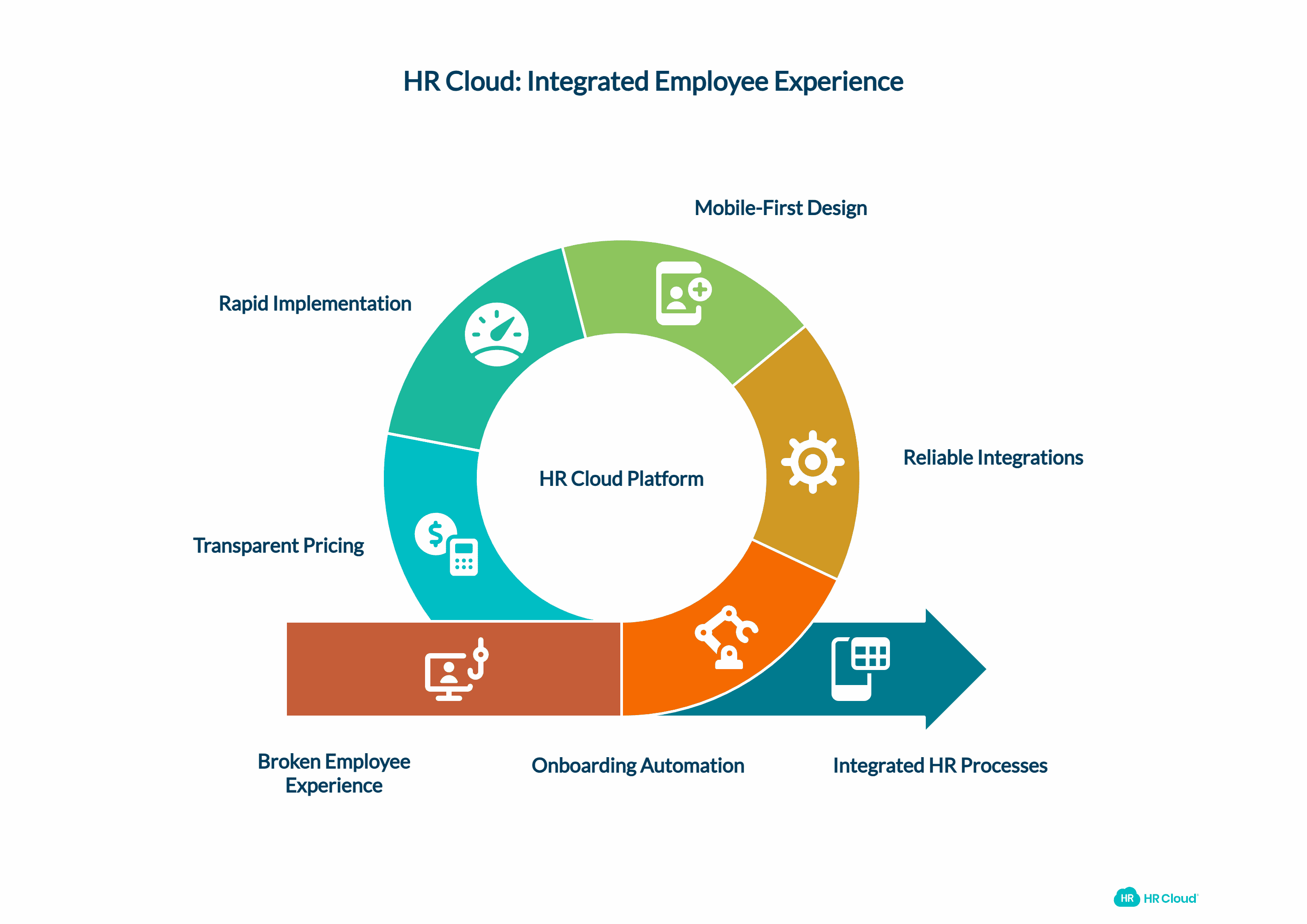
Most buyer guides recite generic feature lists. Let's talk about what actually breaks after you sign the contract—because that's where vendors differ dramatically and where HR Cloud's integrated approach solves problems competitors create.
Real onboarding automation with compliance built in. Can the platform actually automate I-9 documentation with E-Verify integration, not just store PDFs? Does it handle e-signatures with proper audit trails for W-4s, NDAs, and state-specific forms? HR Cloud's Onboard module provides this out of the box, eliminating manual chasing and compliance risks. Workvivo and most social intranets? They'll happily let you post welcome announcements while you manually process all the actual paperwork in separate systems.
Integrations that actually work without breaking. Review sites overflow with complaints about integrations that look good in sales demos but fail in production. Users report connectors that break after platform updates, sync failures requiring constant IT attention, and critical data fields that simply don't map between systems. HR Cloud provides documented integrations with ADP, UKG, QuickBooks, and major ATS platforms that customers praise for reliability. Competitors tout integration marketplaces while users quietly maintain manual workarounds.
Mobile experiences designed for frontline use, not desktop forced onto phones. Enterprise intranets consistently deliver clunky mobile apps that prioritize admin features over employee usability. Research shows 72% of employees consider their digital workplace extremely important, yet platforms like Workvivo struggle with slow mobile performance and notification delays according to actual user reviews. HR Cloud's mobile app provides genuine mobile-first design because frontline adoption actually matters, not just marketing claims.
Implementation measured in weeks, not quarters. Staffbase implementations routinely take six to twelve months. Simpplr requires substantial professional services fees. Firstup demands dedicated communications teams just to get started. HR Cloud typically implements in two to four weeks for standard configurations, delivering value quickly instead of stalling business improvements for months while consultants configure features you'll never use.
Transparent pricing without hidden gotchas. Enterprise vendors play pricing hide-and-seek, forcing prospects through lengthy sales cycles just to discover costs exceed budgets by 2-3x. Users report surprise fees for analytics, integrations, support tiers, and features promised during demos. HR Cloud maintains transparent pricing conversations and includes critical features in base packages instead of nickel-and-diming customers for basics.
Ready to see what an actually integrated platform looks like? Schedule a demo of HR Cloud and watch real onboarding automation with compliance features that competitors simply don't offer.
How Do Workvivo Alternatives Compare on Key Features?
|
Platform |
Best For |
Major Weaknesses from Reviews |
Onboarding & Compliance |
Starting Price |
Overall Rating |
Implementation Time |
|
HR Cloud |
Organizations needing HR workflows + engagement |
Minor learning curve for advanced features |
✓✓ Automated I-9/E-Verify, full compliance workflows |
Mid-range |
4.8/5 ⭐ |
2-4 weeks |
|
Workvivo |
Social engagement only |
No onboarding automation, mobile app performance issues |
✗ None—requires separate tools |
High (per user/year) |
4-8 weeks |
|
|
Simpplr |
Large enterprises with Salesforce expertise |
Requires Salesforce engineering knowledge, high costs, limited customization |
✗ Basic features only |
$30,000+ annually |
6-12 months |
|
|
Staffbase |
Enterprise with $30k+ budget |
Starts at $30,000/year minimum, complex backend, unintuitive structure |
✗ Minimal HR workflows |
$30,000+ annually |
6-12 months |
|
|
Firstup |
Global enterprises with dedicated comms teams |
Requires professional communications staff, high complexity |
✗ Limited compliance |
Enterprise pricing |
6-12 months |
|
|
Blink |
Frontline communication only |
No HR workflow depth, limited integrations |
✗ Basic task management |
Mid-range |
4-6 weeks |
|
|
Connecteam |
Budget-conscious SMBs |
Lacks enterprise integrations, limited scalability |
✗ Basic workflows only |
Low ($29/month) |
1-2 weeks |
|
|
Microsoft Viva |
Microsoft 365 shops willing to compromise |
Lacks purpose-built intranet features, still requires other HR tools |
✗ Minimal standalone HR |
Bundled with M365 |
Varies widely |
|
|
Happeo |
Google Workspace organizations |
No DMs, audio/video messages, unclear navigation |
✗ None—Google integration only |
Quote-based |
4-6 weeks |
|
|
LumApps |
Enterprise needing customization |
Performance issues, poor editor, limited analytics, high costs |
✗ Communications only |
Enterprise pricing |
6-12 months |
This table reveals what vendors hide: most alternatives force you into expensive, complex implementations while still requiring separate tools for actual HR work. HR Cloud solves real problems instead of creating new ones.
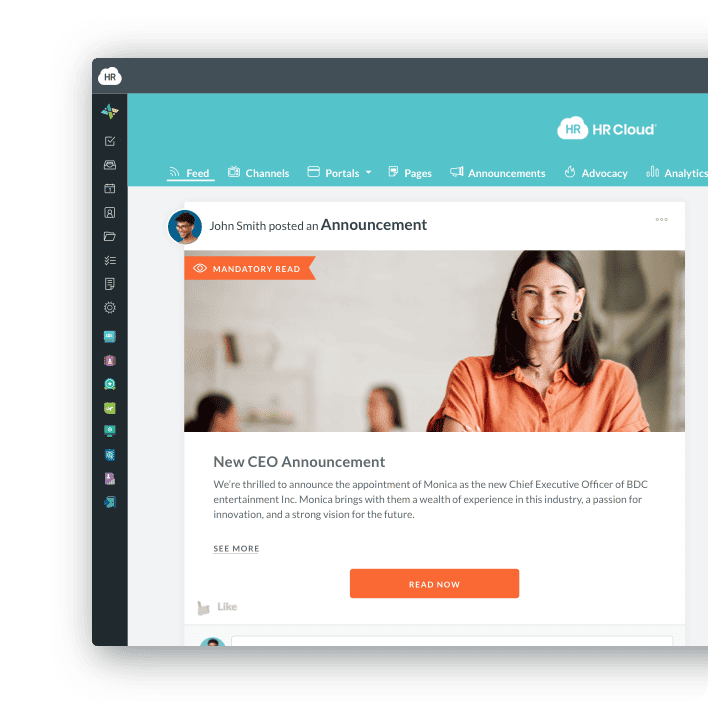
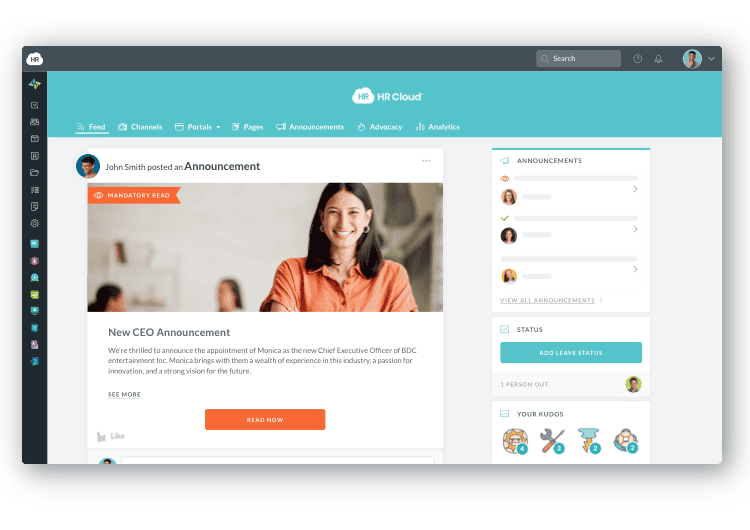
Which Workvivo Alternatives Have the Most User Complaints?
Does Workvivo Actually Deliver on Its Promises?
Workvivo markets itself as the complete employee experience platform, but user reviews tell a different story. The platform excels at creating a social media-style environment for company updates and recognition, but that's where the value stops for organizations needing actual HR functionality.
Critical limitations from user reviews: Multiple reviewers on G2 report that the mobile app is slow with notification delays, stating "the mobile app can sometimes be slow, and notifications don't always arrive instantly. This lag can be frustrating, especially when timely communication is crucial." Another user notes video playback problems: "We often notice glitch while playing videos of high quality and it freezes sometimes. This happens mostly in mobile application." For frontline workers relying on mobile access, these aren't minor annoyances—they're deal-breakers.
The onboarding gap nobody mentions in demos: Workvivo provides zero onboarding automation. No employee recognition workflows, no automated welcome sequences, no structured check-ins that actually help new hires feel connected from day one. Research from Research.com notes that "advanced analytics are missing, providing only basic engagement data" and "customization capabilities are limited." And if you need I-9 workflows, E-Verify integration, or automated document collection with compliance audit trails? You're completely out of luck. You're stuck manually processing new hire paperwork using separate tools, setting up recognition programs in another platform, while Workvivo shows you a pretty newsfeed that doesn't actually solve your HR problems.
Pricing opacity and sales gatekeeping: Connecteam's review reveals that "Workvivo's sales team didn't respond to multiple requests for a demo or quote. Since signing up for the platform isn't possible without speaking to a sales rep first, Workvivo seems to unnecessarily gatekeep its software." Multiple review sites confirm pricing is only available through lengthy sales processes, with per-user annual costs that surprise buyers expecting more competitive rates.
Who actually benefits from Workvivo: Large enterprises (5,000+ employees) that already have separate onboarding tools, compliance systems, and HRIS platforms and simply need a social layer on top. Organizations that need platforms to actually do HR work? You'll be disappointed fast.
Why Do Simpplr Users Complain About Salesforce Requirements?
Simpplr positions itself as an AI-powered enterprise intranet, but the reality beneath the marketing reveals significant limitations that only emerge after purchase.
The Salesforce dependency problem: User reviews on Capterra explicitly warn that "Simpplr is built on Salesforce, and for some this may be a good thing, but because I am not a Salesforce engineer, it can be a real challenge to manage." Another reviewer notes "Simpplr is a little limited in what we can/cannot do and how we can build out sites. Our employees have used Google sites in the past which has a lot of customizable options that we don't have with Simpplr." So much for "AI-powered" flexibility—you need specialized engineering knowledge just to customize basic features.
Time-to-value disaster: While Simpplr markets fast deployment, long-term users discover limitations over time. A Gartner review from June 2025 notes: "The software in general is reliable and easy enough to use… The more you use the software however, you begin to see its limitations." Implementation complexity, combined with discovering feature constraints months into usage, delays ROI significantly.
Cost shock after the demo: Simpplr avoids publishing pricing, forcing prospects through sales cycles. When numbers finally emerge, buyers discover enterprise-level costs that include substantial implementation fees, ongoing professional services, and premium charges for features demonstrated during sales presentations. Organizations budget for mid-market solutions and get enterprise invoices.
The integration promise versus reality: Despite marketing extensive integration capabilities, Connecteam's analysis notes concerns about integration depth and ongoing reliability. Users praise support responsiveness but question why support is needed so frequently for basic operations.
HR workflow gap: Like Workvivo, Simpplr provides no real onboarding automation, no compliance workflows, and no ATS integration. You're paying premium enterprise prices for a sophisticated content management system while still maintaining separate tools for actual HR work.
Tired of platforms that look impressive in demos but disappoint in production? See how HR Cloud delivers automated onboarding workflows that Simpplr simply doesn't offer.
What Makes Staffbase So Expensive Compared to Alternatives?
Staffbase targets enterprise organizations with multi-channel communication needs, but the price-to-value equation creates sticker shock for most buyers once implementation reality sets in.
Pricing barrier excludes mid-market entirely: Connecteam's detailed review reveals that "plans start at $30,000/year, so this software makes sense only for very large companies." The review continues: "With a starting price of $30,000 for a minimum of 1,000 employees, Staffbase simply doesn't make sense for small and medium-sized businesses." That's before implementation fees, training costs, and premium features. Growing companies that might afford Staffbase in 2-3 years? You're priced out today.
Backend complexity frustrates administrators: User reviews consistently mention usability problems that vendor marketing glosses over. Reviews note that "the backend structure can be very unintuitive and hard to understand" and "connecting different organizations sometimes is hard and not very easy to do." Technical teams spend months configuring features that should work out of the box.
Hidden costs beyond base licensing: The $30,000 starting price is just the beginning. Multiple sources report that "Staffbase charges extra fees for features that aren't included in the standard package, such as analytics, integrations, or customizations." Organizations discover that the impressive demo features require premium add-ons not included in initial quotes.
Six to twelve-month implementations: Enterprise platforms like Staffbase require extensive professional services, configuration time, and change management efforts. While HR Cloud implements in 2-4 weeks, Staffbase implementations drag on for quarters, delaying value and frustrating stakeholders who expected faster results.
Still no onboarding automation: Despite premium pricing, Staffbase provides minimal HR workflow capabilities. No automated I-9 processing, no compliance-ready e-signature workflows, no ATS integration. You're paying enterprise prices for internal communications while still maintaining separate onboarding tools.
Firstup: Journey Orchestration That Requires Dedicated Communications Teams
Firstup (formerly SocialChorus) specializes in personalized employee journey orchestration, which sounds sophisticated until you realize it requires enterprise-scale resources and budgets that most organizations don't have.
Complexity requires professional staff: Firstup's journey orchestration and segmentation capabilities demand dedicated internal communications professionals to configure, manage, and optimize. Small HR teams already stretched thin? You'll struggle to extract value from features designed for specialized communicators with time to craft elaborate campaigns.
Enterprise pricing for enterprise-only features: Like Simpplr and Staffbase, Firstup targets global enterprises with thousands of employees and substantial budgets. Implementation requires significant professional services, extended timelines, and ongoing management overhead. Mid-market organizations discover they're paying for sophistication they can't practically use.
Integration complexity: While Firstup emphasizes journey orchestration across channels, actual integration with existing HR systems often requires custom development work. Organizations expect pre-built connectors and discover implementation teams discussing APIs and custom middleware.
The onboarding and compliance void: Firstup focuses on communications and engagement, not HR workflows. No automated onboarding, no compliance management, no integrated ATS or time-off tracking. Organizations maintain expensive Firstup subscriptions while still purchasing separate tools for basic HR functions.
Blink: Mobile-First Communication Without HR Depth
Blink positions itself as the frontline-friendly alternative, delivering mobile-first communication for deskless workers. The platform succeeds at its narrow focus but fails to provide comprehensive HR capabilities that organizations actually need.
Feature limitations beyond communication: While Blink delivers effective mobile messaging, news feeds, and employee directories, review analysis shows it lacks depth in HR workflows. No automated onboarding with compliance features, limited integration with major HRIS platforms, and basic task management that doesn't replace dedicated HR tools.
Integration gaps create vendor sprawl: Organizations choose Blink for frontline communication but quickly discover they need separate tools for onboarding, performance management, time tracking, and benefits administration. What looked like consolidation becomes another tool in an already crowded stack.
Scalability questions for growing companies: While effective for current communication needs, organizations planning growth question whether Blink scales with increasingly complex requirements. The platform works well for straightforward use cases but struggles when organizations need sophisticated workflows or advanced analytics.
Don't settle for communication-only platforms that force you into vendor sprawl. Discover how HR Cloud combines frontline engagement with complete onboarding automation and HRIS capabilities.
Why Can't Connecteam Scale for Growing Companies?
Connecteam offers remarkable value for small businesses with straightforward needs and limited budgets. The trade-off? Organizations outgrow capabilities as they scale and face migration headaches when ready for more sophisticated solutions.
Pricing appeals to budget-conscious SMBs: Starting at just $29/month for up to 30 users with a free plan for teams under 10, Connecteam removes financial barriers for small businesses. This affordability makes it attractive for companies wanting basic employee management without enterprise costs.
Enterprise integration gaps: While perfect for small businesses using simple tools, Connecteam lacks robust integrations with enterprise HRIS systems, advanced ATS platforms, and sophisticated payroll providers. Growing companies discover they're manually bridging data gaps between Connecteam and other essential systems.
Limited scalability creates future migration pain: Organizations that start with Connecteam at 50 employees often face platform replacement discussions at 200-500 employees. Features sufficient for small teams become limiting as complexity grows, forcing expensive migrations to more capable platforms like HR Cloud.
Does Microsoft Viva Really Replace Dedicated Employee Experience Platforms?
Microsoft Viva bundles employee experience capabilities with Microsoft 365 subscriptions, appealing to organizations already invested in the Microsoft ecosystem. The reality? Viva solves some problems while creating others.
Purpose-built features missing: Staffbase's competitive analysis notes that "SharePoint is designed for document storage and collaboration, whereas Workvivo emphasizes employee social networking and community-building." Viva Engage (formerly Yammer) handles social networking but lacks strategic communications capabilities, content governance, and sophisticated engagement features that dedicated platforms provide.
Still requires separate HR tools: Despite Microsoft's comprehensive ecosystem, organizations using Viva still need separate solutions for onboarding automation, compliance management, ATS functionality, and performance reviews. The consolidation promise remains partially fulfilled, with multiple Microsoft tools plus additional vendors required for complete HR operations.
Implementation complexity in large organizations: While Microsoft 365 integration simplifies authentication, large-scale Viva deployments require substantial configuration, change management, and ongoing administration. Organizations discover that "bundled" doesn't mean "simple" when deploying enterprise-scale employee experience capabilities.
What Critical Features Does Happeo Lack for Modern Communication?
Happeo positions itself as a social intranet specifically designed for Google Workspace environments, offering pages, channels, and AI-powered search. While it integrates well with Google's ecosystem, significant feature gaps limit its practical value.
Critical communication limitations: Connecteam's detailed review reveals that "Happeo is not the most advanced communication software. The module lacks essential tools like DMs, audio messages, video messages, and @mentions." In 2025, lacking direct messaging and basic communication features means employees need separate tools just to have conversations—defeating the purpose of a unified platform.
Navigation and user experience problems: Multiple reviewers mention unclear navigation and user experience issues. One Capterra reviewer notes: "Not clear navigation when changing pages," while another states "there are too many options with regards the structure of the platform and pages. It would be easier if there was a few page templates to use rather than everything bespoke." Organizations waste time figuring out how to navigate instead of actually communicating.
Pricing opacity and add-on costs: Happeo uses quote-based pricing with no published rates, forcing prospects through sales processes to discover costs. Reviews indicate extra costs for add-ons like "advanced control, advanced provisioning, and implementation services." The Starter plan has no minimum user count, but Growth and Enterprise plans start at 75 users with annual-only subscriptions.
Missing features users expect: Capterra reviews consistently mention "a few missing features" and limited customization for users. One reviewer states: "No or minimal opportunity for users to customize the content themselves, e.g. give the users the possibility to select what they what to see in the homepage." Users can't personalize their experience, reducing engagement and adoption.
The HR workflow void: Like other social intranets, Happeo provides zero onboarding automation, no compliance management, and no ATS integration. You're paying for a Google-integrated intranet while still maintaining separate systems for actual HR work.
Why Do LumApps Users Report Such Poor Experiences?
LumApps markets itself as an enterprise employee experience platform integrating with both Microsoft 365 and Google Workspace. The reality involves high costs, technical complexity, and performance problems that only surface after purchase.
Devastating usability complaints: One GetApp UK reviewer provides a brutally honest assessment: "Completely terrible, only way to describe it. The only thing worse than the actual product is support for the product. Everything is an 'FR' that will take 6 months to a year to complete, or is tagged as 'functioning as designed'. There's not one thing I find usable about this software. The editor is horrible, the search is useless, It doesn't autoscale to your resolution, support is non-existent."
Performance problems administrators report: Multiple reviewers mention that "the page-building interface can sometimes be very slow and very RAM-intensive, bringing page editing to a crawl." Administrators waste time waiting for pages to load instead of actually creating content. One reviewer notes the platform "doesn't autoscale to your resolution," creating additional usability headaches.
Pricing concerns for smaller organizations: Reviews consistently mention that "the price is a bit high for my budget" and express concerns about affordability for smaller organizations. TrustRadius analysis reveals "mixed opinion regarding its affordability, particularly for smaller organizations that may find the platform's pricing prohibitive if they do not require the full suite of features."
Analytics limitations: Software Reviews notes that "while it gives basic metrics like page visits and clicks, it doesn't dive deep into engagement data. For example, it's hard to measure the actual impact of certain content pieces beyond surface-level stats." Organizations can't prove ROI or optimize strategies with shallow analytics.
Setup difficulty despite simplicity claims: G2 reviews mention that "the software is amazingly simple and easy to use. I don't like how hard it can be to setup though." Organizations face difficult implementations despite vendors promising ease of deployment. Another reviewer notes missing features like "No scrolling text widget or functionality" and style settings that "can't delete old trial setting and can't update a setting you have saved."
Engagement challenges for bottom-up communication: Capterra reviews reveal that "LumApps is very good for top-down messages, it's harder to allow people to share best practices or to allow them to decide what content is most relevant for them resulting in lower levels of engagement than expected." One-way communication fails to engage employees who want participatory experiences.
The onboarding gap persists: LumApps focuses on communications and content management, providing no real onboarding automation, compliance workflows, or ATS integration. Enterprise pricing doesn't include enterprise HR functionality.
What Problems Do All These Alternatives Create?
Reading through hundreds of user reviews across G2, Capterra, and other review sites reveals consistent patterns where popular alternatives disappoint. Understanding these recurring failures helps explain why organizations increasingly choose HR Cloud's integrated approach.
The onboarding automation gap: Workvivo, Simpplr, Staffbase, Firstup, Blink, and most alternatives provide zero real onboarding automation. They'll store documents and display welcome messages, but they won't automate I-9 workflows with E-Verify integration, collect e-signatures with compliance audit trails, or integrate with your ATS to eliminate duplicate data entry. HR Cloud's Onboard module provides this out of the box, automating workflows that competitors force you to handle manually in separate systems.
Integration brittleness nobody warns about: Review sites overflow with complaints about integrations that break after platform updates, sync failures requiring constant IT attention, and critical data fields that don't map between systems. Vendors tout integration marketplaces during demos while users quietly maintain manual workarounds. HR Cloud's documented integrations with ADP, UKG, and major platforms receive praise for reliability because they're built to work, not just to check marketing boxes.
Enterprise pricing with SMB promises: Staffbase requires $30,000 minimum annual spend. Simpplr charges enterprise rates with substantial implementation fees. Firstup targets global organizations with matching budgets. All market to mid-market buyers while pricing them out during sales conversations. HR Cloud maintains mid-market pricing that matches capabilities to actual budgets, implementing in weeks versus quarters.
Mobile experiences that disappoint frontline workers: Despite marketing mobile-first capabilities, platforms like Workvivo struggle with slow app performance, notification delays, and video playback problems, according to actual user reviews. Enterprise intranets prioritize desktop admin features and treat mobile as afterthoughts. HR Cloud designed mobile experiences for actual frontline use, not just marketing materials.
Time-to-value measured in quarters, not weeks: Enterprise platforms routinely require six to twelve months for full deployment, delaying ROI and frustrating stakeholders. HR Cloud typically implements in two to four weeks, delivering value quickly because standard configurations work without months of professional services.
How Does HR Cloud Solve These Common Platform Problems?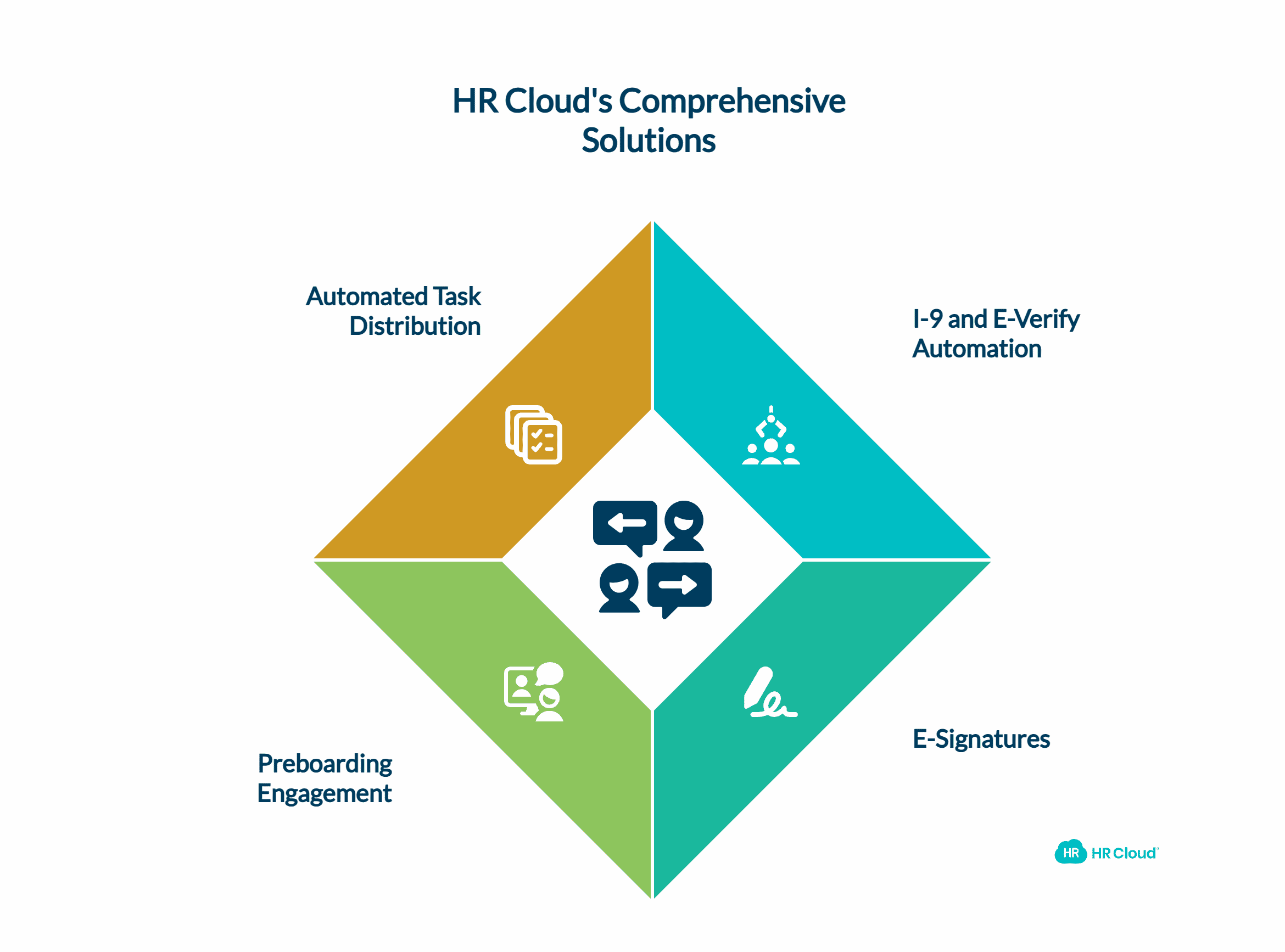
Most platforms force impossible choices: sophisticated enterprise features with enterprise complexity and costs, or affordable tools that lack capabilities you'll desperately need as you grow. HR Cloud provides a practical middle path that combines essential capabilities without the vendor sprawl, implementation nightmares, or pricing surprises that plague alternatives.
Does HR Cloud Really Automate I-9 and E-Verify Compliance?
Here's where HR Cloud fundamentally differs from every alternative discussed. The Onboard solution doesn't just store onboarding documents—it automates complete workflows from preboarding through day-one and beyond, with compliance features competitors simply don't offer:
I-9 and E-Verify automation integrated into workflows means hiring teams add compliance documentation directly into onboarding processes, ensuring nothing gets missed. The system tracks completion automatically, sends intelligent reminders, and maintains audit trails that satisfy regulators. Try finding this in Workvivo, Simpplr, or Staffbase—you won't, because they're not HR platforms despite the marketing claims.
E-signatures for every document with proper legal standing—W-4s, NDAs, benefit enrollments, policy acknowledgments—eliminate paper chasing entirely. New hires complete forms remotely before their start date, and HR teams gain real-time visibility into outstanding items without constant follow-up. Organizations report cutting onboarding time by 60% with automated workflows versus manual processes competitors force.
Preboarding capabilities that actually engage new hires before day one by providing access to welcome kits, training materials, and required forms. This reduces first-day overwhelm and helps employees contribute immediately instead of spending week one drowning in paperwork. Competitors talk about employee experience while HR Cloud actually delivers it where it matters most—during the critical first days.
Automated task distribution across HR, IT, managers, and new hires with built-in reminders and escalations eliminates the coordination headaches that plague manual processes. Nothing falls through cracks because the system tracks accountability automatically. This isn't engagement theater—it's operational excellence.
Ready to eliminate onboarding chaos with real automation? See HR Cloud's Onboard workflows in action during a personalized demo.
How Does Workmates Compare to Standalone Social Intranets?
HR Cloud's Workmates platform delivers the employee engagement features organizations expect from dedicated intranet solutions, but with a critical advantage competitors lack: tight integration with core HR data and workflows that eliminates the data silos plaguing other platforms.
Social intranet with content management that works provides company announcements, policy updates, team news, and knowledge sharing that employees can access across desktop and mobile devices. Unlike enterprise intranets requiring Salesforce engineers to customize, Workmates offers intuitive content management that HR teams actually use.
Employee recognition that drives measurable engagement facilitates peer-to-peer acknowledgment and milestone celebrations tied to company values. Recognition drives 12x higher engagement according to workplace research, and Workmates makes recognition natural and frequent instead of forced and awkward.
Mobile app with genuine frontline design ensures workers without desks stay connected with company news, access policies, submit time-off requests, and participate in recognition—all from phones. Unlike Workvivo's slow, glitchy mobile experience, HR Cloud's app works reliably because mobile isn't an afterthought.
The integration advantage nobody else offers: Workmates connects directly with HR Cloud's People HRIS, Onboard, and Recruit modules, automatically populating employee directories, organizational charts, time-off balances, and performance data without manual updates or complex integrations. This eliminates the data sync nightmares that plague organizations using separate best-of-breed tools.
Integrations, Implementation Speed, and Real Total Cost of Ownership
HR Cloud connects with major platforms through documented integrations that customers praise for reliability: ADP, UKG (Ultimate Kronos Group), QuickBooks, and leading applicant tracking systems. These pre-built connectors reduce implementation complexity and eliminate ongoing maintenance headaches.
Two to four-week implementations versus six to twelve months means organizations see value in weeks instead of waiting quarters for consultant-heavy enterprise deployments. Standard configurations work immediately because they're designed for common business needs, not theoretical edge cases requiring months of customization.
SOC 2 certification demonstrates security commitment that matches or exceeds competitors while providing compliance-ready audit trails for regulated industries. Healthcare, finance, and other sectors with stringent requirements trust HR Cloud with sensitive employee data.
Transparent pricing without surprise fees means organizations budget accurately instead of discovering hidden costs for analytics, integrations, premium features, or support tiers after signing contracts. Mid-market pricing matches mid-market capabilities and budgets realistically.
Real Scenarios: When HR Cloud Makes More Sense Than Alternatives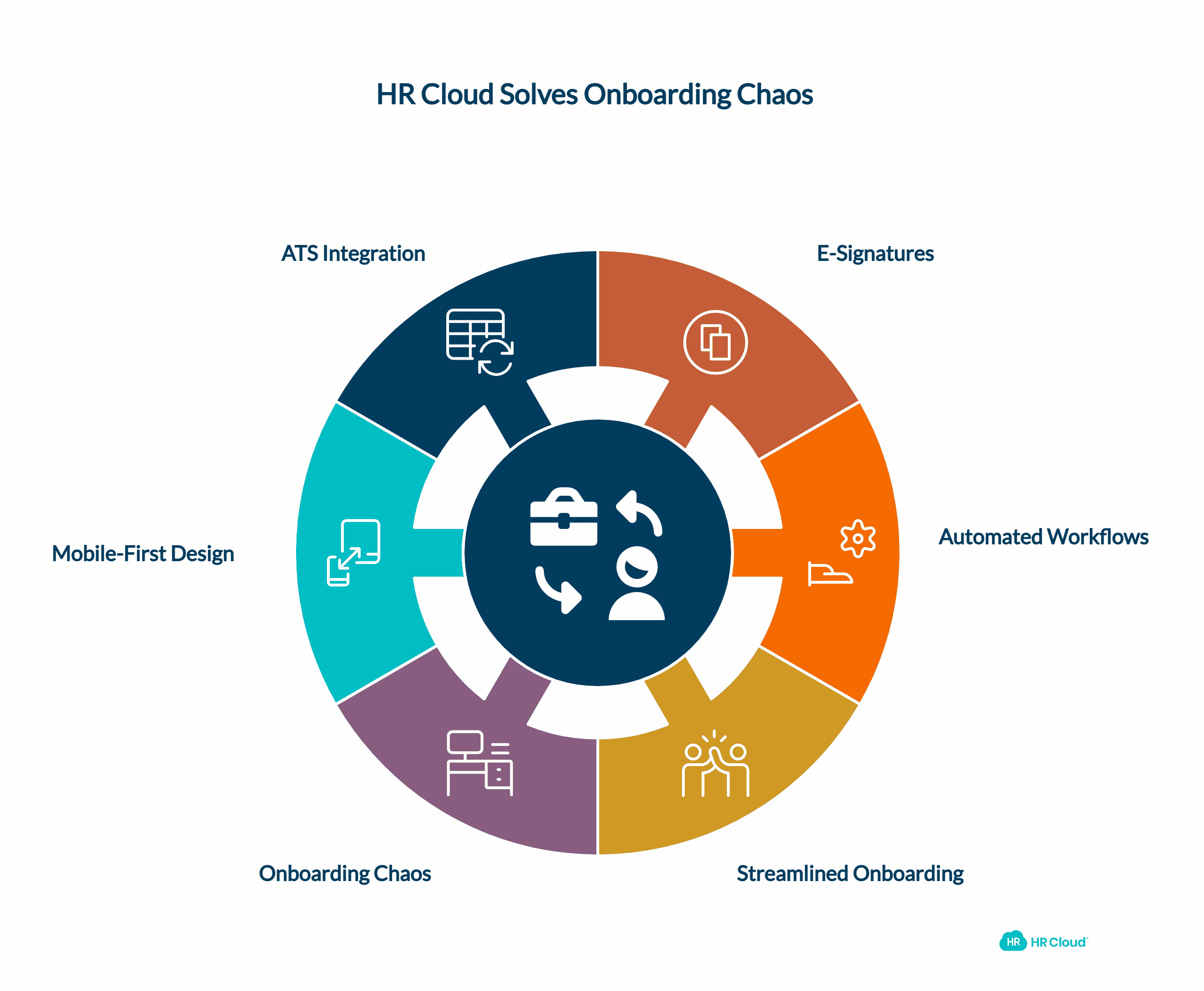
Generic vendor comparisons miss the point because your specific situation determines what matters. Here's when HR Cloud's integrated approach solves problems alternatives create:
Fast-Growing Companies Drowning in Onboarding Chaos
You're hiring 10-30 people per quarter and HR is overwhelmed chasing paperwork, IT forgets laptop orders, managers don't complete assigned tasks, and new hires feel confused and unsupported during critical first weeks. Workvivo gives you a pretty newsfeed while onboarding burns.
What you actually need: Automated onboarding workflows that distribute tasks, track completion, send intelligent reminders, and maintain compliance audit trails. E-signatures that work legally, preboarding that engages hires before day one, and integration with your ATS that eliminates duplicate data entry. Plus engagement tools that maintain culture as you scale.
Why HR Cloud wins: Onboard automates the workflows killing your team's productivity while Workmates handles engagement and culture-building. Typical implementation completes in 2-4 weeks, not 6-12 months. You get one platform for onboarding plus engagement instead of duct-taping together separate tools that don't talk to each other.
Competitors that disappoint: Workvivo provides zero onboarding automation. Connecteam offers basic task lists but lacks compliance features. Staffbase costs $30,000+ and still requires separate onboarding tools. Simpplr needs Salesforce engineers for basic customization.
Remote-First Organizations Fighting Compliance Across Jurisdictions
Your distributed team works from multiple states or countries, creating compliance nightmares for I-9 documentation, state-specific forms, and audit-ready records. You need remote onboarding that actually works, not document storage pretending to be automation.
What you actually need: Remote onboarding with built-in compliance that handles I-9 and E-Verify requirements, collects e-signatures with legal standing, manages state-specific documentation variations, and provides audit trails that survive regulatory scrutiny. Plus mobile capabilities for employees who'll never visit offices.
Why HR Cloud wins: Built-in I-9/E-Verify automation, SOC 2 security, compliance-ready audit trails, and genuine mobile-first design for remote workers. Workmates keeps distributed teams connected despite physical distance through recognition, communication, and culture-building features that actually work remotely.
Competitors that fail: Workvivo, Simpplr, Staffbase, Firstup, and Blink all lack real compliance automation. You're manually processing I-9s and hoping you don't fail audits while paying thousands for engagement features that don't solve your actual problems.
Frontline-Heavy Organizations Needing Mobile That Actually Works
More than half your workforce works retail stores, healthcare facilities, manufacturing plants, or hospitality venues. They need reliable mobile access to schedules, policies, company news, and time-off requests, but Workvivo's glitchy mobile app frustrates them with slow performance and video playback problems.
What you actually need: Mobile-first design that works reliably, not desktop software forced onto phones. Quick information access, simple time-off workflows, schedule visibility, and communications optimized for employees checking phones during breaks, not throughout workdays.
Why HR Cloud wins: Mobile app designed for actual frontline use, not just marketing materials. Workmates provides engagement and communication while integrated time-off and scheduling eliminate separate tools. Implementation takes weeks, not months, getting value to frontline workers quickly.
Competitors with mobile problems: Workvivo users explicitly report slow mobile app performance, notification delays, and video playback issues. Staffbase requires $30,000 minimum. Simpplr prioritizes desktop admin features. Enterprise platforms treat mobile as afterthoughts despite frontline promises.
Stop settling for platforms that promise the world and deliver fragments. See how HR Cloud's integrated approach actually solves your problems.
The Questions That Expose Platform Weaknesses During Evaluations
Skip the softball questions vendors rehearse and probe areas where platforms actually fail after purchase. HR Cloud welcomes these tough questions because we solve the problems competitors create:
"Show me exactly how your platform automates I-9 workflows with E-Verify integration and provides compliance-ready audit trails." Workvivo, Simpplr, Staffbase, Firstup, Blink—they'll fumble this because they can't do it. HR Cloud demonstrates it in every demo because it's built in, not bolted on as an afterthought.
"What happens when your integrations break after platform updates? How quickly does support respond and who pays for fixes?" Competitors avoid this question because broken integrations plague their customers. HR Cloud maintains documented integrations that work reliably because we prioritize customer operations over feature announcements.
"Provide complete first-year cost breakdown including licensing, implementation services, training, integration work, and any premium features required for capabilities shown in demos." Enterprise vendors dance around this with vague ranges and "contact sales" deflections. HR Cloud provides transparent pricing discussions upfront because we don't hide costs in fine print.
"Show me your actual implementation timeline with specific milestones and what causes delays beyond your control." Staffbase, Simpplr, and Firstup quote 6-12 months but blame "customer readiness" when timelines stretch. HR Cloud implements in 2-4 weeks for standard configurations because we designed for practical deployment, not consultant billing opportunities.
"Can I speak with three customers in my industry who implemented within the past year and are actively using features I'm evaluating?" Vendors offer cherry-picked references from years ago or different use cases. Insist on recent, relevant references who'll tell you what actually happened versus what was promised.
"What features shown in this demo require additional licensing, professional services, or technical expertise beyond standard HR team capabilities?" Simpplr's Salesforce dependency, Staffbase's backend complexity, and Firstup's communications team requirements only surface after contracts are signed. HR Cloud's standard configurations work for typical HR teams without specialized engineering.
"What's your average support response time and resolution rate for integration issues?" Review sites reveal support problems, but vendors quote best-case scenarios. Probe specific issue categories where competitors consistently fail customers.
Pricing Reality: What You'll Actually Pay (And What Vendors Hide)
Pricing opacity frustrates buyers trying to budget appropriately. Here's what research across review sites and customer conversations reveals—and why HR Cloud's transparency stands out:
Entry-level platforms like Connecteam range from $29-99/month for under 200 users, appealing for small businesses but creating migration pain as organizations grow. You'll outgrow capabilities within 12-24 months and face platform replacement costs.
Mid-market platforms including HR Cloud generally price in the $3-8 per user per month range for comprehensive HR and engagement features, with transparent implementation fees of $5,000-25,000 depending on complexity. This represents genuine value because you're replacing multiple separate tools with one integrated platform.
Enterprise intranets like Simpplr, Staffbase, and Firstup often quote $8-15+ per user monthly with substantial implementation fees starting at $50,000 and frequently exceeding $200,000 for large, complex deployments. Then discover surprise charges for analytics, integrations, and features promised during sales presentations.
The hidden costs nobody warns about: Integration work often runs $10,000-50,000 unless pre-built connectors exist and actually work. Ongoing administrator time managing platform complexities. Training expenses for technical features requiring specialized knowledge. Premium support tiers because standard support proves inadequate. Annual price increases buried in contract renewal terms.
Workvivo's pricing surprise: Despite marketing to mid-market organizations, Workvivo charges per-user annual fees that surprise buyers expecting more competitive rates, with no pricing published and lengthy sales cycles required just to get quotes. Organizations discover they're paying premium prices for platforms lacking basic HR workflows.
Ready for transparent pricing discussion without games? Schedule an honest conversation about total costs with HR Cloud.
How Organizations Actually Measure Success With HR Cloud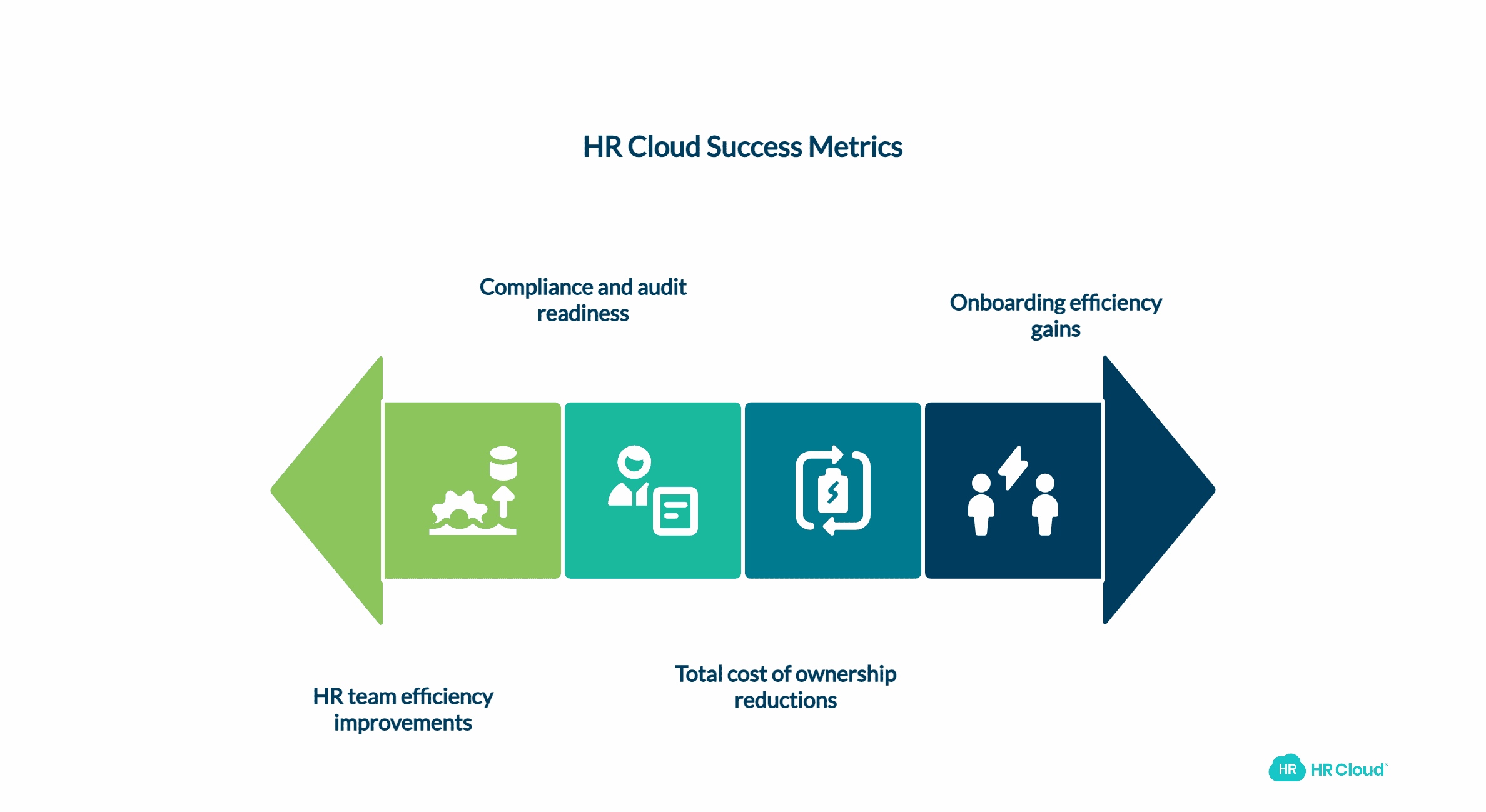
Success metrics vary by priorities, but effective HR Cloud implementations consistently deliver measurable improvements across multiple dimensions that competitors struggle to match:
Onboarding efficiency gains: Organizations implementing automated onboarding reduce time-to-productivity by 30-60%, meaning new hires contribute value faster and feel less overwhelmed during critical early days. Competitors force manual processes that waste time and create confusion.
Compliance and audit readiness: Completion rates for required documents improve dramatically with automated workflows that track progress and send intelligent reminders. Audit trails satisfy regulators without manual documentation compilation. Organizations avoid expensive violations and failed audits that platforms lacking compliance features risk.
HR team efficiency improvements: Administrative time saved through automation, elimination of duplicate data entry between systems, reduction in support tickets for basic questions employees self-serve, and decreased IT burden for platform maintenance. HR teams redirect time from administrative drudgery to strategic initiatives that actually improve employee experience.
Engagement and retention metrics: Platform adoption rates, content engagement patterns, recognition frequency, and voluntary turnover improvements demonstrate whether platforms actually enhance employee experience or just create unused tools. Research shows employees with positive experiences are 16 times more engaged than those with negative experiences—HR Cloud delivers measurable engagement improvements, not engagement theater.
Total cost of ownership reductions: Replacing multiple separate vendors with one integrated platform reduces total costs, simplifies administration, eliminates integration maintenance, and decreases training requirements. Organizations measure ROI in months, not years, because value delivery happens quickly with 2-4 week implementations versus competitors' 6-12 month delays.
Making Your Final Decision: Why HR Cloud Makes Practical Sense
You've reviewed alternatives, understood their limitations, and likely feel frustrated that platforms promising complete solutions actually deliver fragments requiring additional tools. Here's why HR Cloud's integrated approach solves problems instead of creating them:
One platform for onboarding, engagement, and core HR workflows eliminates vendor sprawl, integration nightmares, and data silos. You're not duct-taping together Workvivo for engagement, a separate onboarding tool, an ATS, and time-tracking software—you're using one comprehensive platform designed to work together.
Automated compliance that actually works with built-in I-9 and E-Verify integration, e-signatures with legal standing, and audit trails that satisfy regulators. Stop manually processing compliance paperwork and hoping you don't fail audits—HR Cloud automates workflows that competitors force you to handle in separate systems.
Implementations measured in weeks, not quarters mean you're delivering value to employees and seeing ROI quickly instead of waiting six to twelve months for consultant-heavy enterprise deployments that still require configuration after go-live.
Transparent pricing without hidden gotchas lets you budget accurately instead of discovering surprise fees for features, integrations, analytics, or support tiers after signing contracts. Mid-market pricing matches mid-market budgets realistically, not enterprise prices for mid-market promises.
Support that responds when you need help instead of forcing ticket escalations and lengthy resolution times that leave critical business processes broken. HR Cloud prioritizes customer success over sales pipeline because satisfied customers renew and refer.
SOC 2 security and compliance that matches or exceeds enterprise competitors while maintaining practical implementation timelines and reasonable costs. Regulated industries trust HR Cloud with sensitive employee data.
Stop settling for platforms that create more problems than they solve. Schedule a demo and see why organizations choose HR Cloud over Workvivo and expensive enterprise alternatives.
Next Steps: See Why Organizations Choose HR Cloud Over Workvivo
You've invested time understanding why popular alternatives disappoint after the demos end and contracts are signed. You've seen how Workvivo lacks onboarding automation, how Simpplr requires Salesforce engineers, how Staffbase costs $30,000+ annually while still needing separate HR tools, and how most platforms promise completeness while delivering fragments.
HR Cloud solves the problems competitors create by combining automated onboarding with built-in compliance, social intranet engagement through Workmates, ATS integration, and time-off management in one platform that implements in weeks instead of quarters. You're not forced to choose between affordable tools that lack capabilities and enterprise platforms with enterprise complexity and costs—you're getting practical functionality at realistic prices.
Schedule a transparent demo that shows actual onboarding automation with I-9/E-Verify workflows competitors can't match. Watch real compliance features, not document storage pretending to be automation. See integrations that work reliably instead of marketing promises that fail in production. Experience mobile design created for frontline workers, not desktop software forced onto phones.
Speak with customer references in your industry who implemented recently and use features you're evaluating. Ask about implementation accuracy versus reality, integration reliability, support responsiveness, and whether they'd choose HR Cloud again knowing what they know now.
Compare total first-year costs transparently including licensing, implementation services, integration work, and ongoing administration. Discover why HR Cloud delivers better value than alternatives charging more for less capability.
Ready to solve your HR problems instead of creating new ones? Schedule your personalized HR Cloud demo and see the difference integrated platforms make.
The right platform helps your organization grow, keeps employees engaged and productive, and makes your HR team's lives easier instead of harder. Choose platforms that solve real problems over those that create engagement theater while leaving you drowning in manual workflows.
 Discover how our HR solutions streamline onboarding, boost employee engagement, and simplify HR management
Discover how our HR solutions streamline onboarding, boost employee engagement, and simplify HR management
Frequently Asked Questions
What makes HR Cloud better than Workvivo for mid-sized companies?
HR Cloud solves the critical problem Workvivo ignores: actual HR workflow automation. While Workvivo provides a social media-style engagement platform, it offers zero onboarding automation, no I-9/E-Verify integration, and no compliance-ready workflows. You're forced to maintain expensive separate systems for onboarding, ATS, time tracking, and compliance management while Workvivo shows pretty newsfeeds. HR Cloud combines automated onboarding with built-in compliance, Workmates social intranet, ATS integration, and time-off management in one platform that implements in 2-4 weeks versus 6-12 months for enterprise alternatives. Plus, Workvivo users report mobile app performance problems including slow loading times and notification delays, while HR Cloud's mobile app works reliably for frontline workers. The choice is clear: pay for engagement theater with Workvivo while maintaining separate HR tools, or get complete functionality with HR Cloud.
Why do enterprise platforms like Simpplr and Staffbase cost so much more than HR Cloud?
Enterprise platforms charge premium prices but deliver limited value for mid-market organizations. Staffbase requires $30,000 minimum annual spend with 6-12 month implementations and additional fees for analytics, integrations, and customizations not included in base pricing. Simpplr requires Salesforce engineering expertise just to customize basic features and costs escalate quickly with professional services fees and premium charges. Both platforms still lack the onboarding automation and compliance workflows that organizations desperately need, forcing separate tool purchases. HR Cloud provides comprehensive capabilities—automated onboarding, compliance management, social intranet, ATS integration, time-off tracking—at mid-market pricing with transparent implementations completing in 2-4 weeks. You're not paying for enterprise complexity you don't need or features that require specialized technical staff to manage. HR Cloud delivers practical functionality at realistic prices without surprise fees or hidden costs that plague enterprise vendors.
Does HR Cloud actually automate I-9 and E-Verify compliance?
Yes, and this is where HR Cloud fundamentally differs from competitors. The Onboard module provides built-in I-9 and E-Verify automation that integrates directly into onboarding workflows, ensuring nothing gets missed and maintaining compliance-ready audit trails. Hiring teams add compliance tasks to workflows, the system tracks completion automatically, sends intelligent reminders to employees and HR staff, and creates documentation that satisfies regulatory audits. This isn't document storage pretending to be automation—it's real workflow automation with compliance built in from the ground up. Compare this to Workvivo, Simpplr, Staffbase, Firstup, and Blink, which provide zero compliance automation and force organizations to manually process I-9 documentation using separate tools while hoping they don't fail audits. Organizations in regulated industries or those facing compliance scrutiny need platforms with built-in compliance capabilities, not engagement-only tools that create additional administrative burden.
How quickly can we actually implement HR Cloud compared to alternatives?
HR Cloud typically implements in 2-4 weeks for standard configurations, delivering value quickly instead of the 6-12 month implementation timelines common with Simpplr, Staffbase, and Firstup. Why the dramatic difference? HR Cloud designed standard configurations that work for common business needs without months of customization, consulting fees, and change management overhead that enterprise platforms require. You're not waiting for Salesforce engineers to configure basic features or professional services teams to build custom integrations—pre-built capabilities work immediately because they're designed for practical deployment. This means employees see value in weeks, HR teams start saving time quickly, and ROI begins accumulating instead of waiting quarters while consultants configure features you'll partially use. Organizations tired of implementation delays that stall business improvements choose HR Cloud for practical timelines that actually happen versus enterprise promises that consistently slip.
Can small companies afford HR Cloud or is it only for enterprises?
HR Cloud specifically serves growing small to mid-market organizations (50-2,000 employees) that need more capability than entry-level tools like Connecteam provide but can't afford or justify the $30,000+ annual minimums and enterprise complexity of Staffbase, Simpplr, or Firstup. Mid-market pricing typically ranges $3-8 per user per month for comprehensive HR and engagement features, making it accessible for growing companies while delivering enterprise-grade capabilities. Small companies with 50-200 employees successfully implement HR Cloud because standard configurations work without requiring dedicated IT teams or specialized technical staff. You're not paying for sophistication you can't practically use or complexity that requires consultants to manage—you're getting practical functionality at realistic prices with transparent implementations. Organizations outgrowing Connecteam or BambooHR discover HR Cloud provides the additional capabilities they need without forcing them into enterprise price brackets or implementation nightmares.
What integration capabilities does HR Cloud actually provide?
HR Cloud offers documented integrations with major HRIS platforms including ADP, UKG (Ultimate Kronos Group), QuickBooks, and leading ATS systems through pre-built connectors that customers praise for reliability in reviews. These aren't theoretical integrations that look good in marketing materials but fail in production—they're working connections that organizations depend on daily for payroll sync, employee data management, and recruiting workflows. Compare this to competitors where review sites overflow with complaints about integrations that break after platform updates, sync failures requiring constant IT attention, and critical data fields that don't map correctly between systems. HR Cloud prioritizes integration reliability because customer operations depend on data flowing correctly between systems, not just checking feature boxes on comparison charts. Additionally, the tight integration between HR Cloud's own modules (Onboard, Workmates, People HRIS, Recruit ATS) eliminates the data silos and integration nightmares that plague organizations using separate best-of-breed tools from multiple vendors.
How does HR Cloud's mobile app compare to Workvivo's reported performance problems?
This is a critical distinction that reveals design priorities. Multiple Workvivo users on G2 explicitly report mobile app performance problems including slow loading times, notification delays that frustrate timely communication, and video playback glitches especially on mobile devices. One reviewer states: "the mobile app can sometimes be slow, and notifications don't always arrive instantly. This lag can be frustrating, especially when timely communication is crucial." Another notes: "We often notice glitch while playing videos of high quality and it freezes sometimes. This happens mostly in mobile application." For frontline workers relying on mobile access, these aren't minor annoyances—they're reasons employees stop using the platform. HR Cloud designed mobile experiences for actual frontline use from the beginning, not desktop software forced onto phones as an afterthought. The app works reliably because mobile accessibility isn't a marketing claim—it's a core design principle validated by frontline workers who depend on it daily for schedules, time-off requests, company news, and recognition.
Do we really need onboarding automation or can we just use a social intranet?
This question reveals why many organizations discover platforms disappoint after purchase. Social intranets like Workvivo, Simpplr, and Staffbase excel at engagement and communication but provide zero help with the administrative drudgery killing your HR team's productivity—collecting I-9 forms, managing E-Verify requirements, tracking document completion, ensuring compliance audit readiness, eliminating duplicate data entry between systems. Organizations report cutting onboarding time by 60% with automated workflows versus manual processes. That's new hires contributing value faster, HR teams redirecting time to strategic initiatives, compliance risks reduced dramatically, and early retention improving because onboarding feels professional instead of chaotic. You absolutely need onboarding automation if you're hiring regularly, facing compliance requirements, or tired of HR staff drowning in paperwork while separate tools handle engagement. HR Cloud provides both—automated onboarding with compliance built in plus Workmates social intranet for engagement—eliminating the false choice competitors force.
What happens if we outgrow HR Cloud's capabilities?
This question assumes platform limitations that don't match reality. HR Cloud serves organizations from 50 to 2,000+ employees across industries including healthcare, manufacturing, technology, hospitality, and professional services. The platform scales with organizational growth through configurable workflows, user role management, advanced analytics, and integration capabilities that expand as needs evolve. Organizations that start with HR Cloud at 100 employees successfully scale to 500, 1,000, and beyond without platform replacements because core capabilities grow with business requirements. Compare this to Connecteam, where organizations outgrow capabilities at 200-500 employees and face expensive migrations, or enterprise platforms where you're paying for sophistication you won't need for years. HR Cloud's sweet spot—growing organizations that need practical functionality without enterprise complexity or costs—means you're choosing a platform that scales with your business instead of forcing premature replacement decisions.
How does HR Cloud handle companies with frontline plus office workers?
HR Cloud specifically designed for hybrid workforces where some employees sit at desks while others work retail stores, healthcare facilities, manufacturing plants, or field locations. The mobile app provides genuine frontline-friendly design with quick access to schedules, time-off requests, company news, policies, and recognition—optimized for employees checking phones during breaks rather than throughout workdays. Desktop experiences serve office workers and administrators with content management, analytics, workflow configuration, and reporting capabilities. Critically, the platform maintains data consistency between mobile and desktop because it's one integrated system, not separate tools clumsily connected. Frontline workers see the same company announcements, participate in the same recognition programs, and access the same resources as office employees—eliminating the two-tier experience that creates culture problems in organizations using different tools for different worker types. This unified approach ensures every employee feels valued and connected regardless of where they work.
What support does HR Cloud actually provide after implementation?
Support quality separates platforms that work long-term from those that frustrate customers after the honeymoon period ends. HR Cloud provides responsive support through multiple channels because customer success determines renewal rates and referrals—not just initial sales. Organizations receive dedicated customer success managers who proactively check in, help optimize platform usage, and solve problems before they escalate. Technical support responds to issues quickly instead of forcing ticket escalations through multiple tiers that waste days while critical workflows remain broken. Compare this to enterprise vendors where review sites reveal support problems including slow response times, difficulty reaching knowledgeable staff, and premium support tiers required to receive adequate assistance. HR Cloud includes solid support in base pricing because platforms that don't work reliably don't deliver value regardless of feature sophistication. Organizations evaluate support quality by speaking with customer references about actual experiences, not relying on vendor promises that often disappoint after contracts are signed.
Can HR Cloud replace multiple existing tools or will we still need separate systems?
HR Cloud specifically designed to replace multiple separate vendors with one integrated platform, reducing total cost of ownership, eliminating integration maintenance, and simplifying administration. Organizations typically consolidate onboarding tools, ATS platforms, employee directories, time-off tracking systems, social intranets, and recognition programs into HR Cloud's comprehensive suite. The Onboard module handles new hire workflows with compliance automation. Recruit ATS manages applicant tracking and hiring processes. People HRIS provides employee data management and organizational structure. Workmates delivers social intranet and engagement features. Time-off tracking integrates with payroll systems. All modules share data automatically because they're purpose-built to work together, eliminating the integration nightmares and data silos that plague organizations using best-of-breed tools from multiple vendors. You might still need specialized tools for benefits administration or payroll processing depending on your providers, but HR Cloud eliminates most of the vendor sprawl creating administrative overhead and integration headaches. The platform consolidates core HR and engagement functions into one system that actually works together instead of theoretically integrating.

Keep Reading
A Guide to Integrating Employee Engagement Platforms with ADP Canada
A recent report by the Canada Human Resource Center revealed that 60% of Canadian
A Closer Look at HR Cloud-ADP Integrations
ADP is the gold standard for payroll and core HR management. But if you’ve ever tried to
The Future of Time Off and Absence Management: HR Cloud and ADP WFN
Leave management is a mess these days. Keeping track of PTO, sick days, and all the other
Like What You Hear?
We'd love to chat with you more about how HR Cloud® can support your business's HR needs. Book Your Free Demo

Build a Culture of Recognition. Boost Engagement. Guaranteed.
Workmates empowers employees to stay informed, connected, and appreciated—whether they’re on the front line, in the office, or remote. Recognition drives 12x higher engagement.Trusted by industry leaders in every sector




Cut Onboarding Costs by 60%.
Take the confusion and follow-ups out of onboarding with automated workflows, digital forms, and structured portals—so new hires ramp faster 3X quicker.Trusted by industry leaders in every sector




